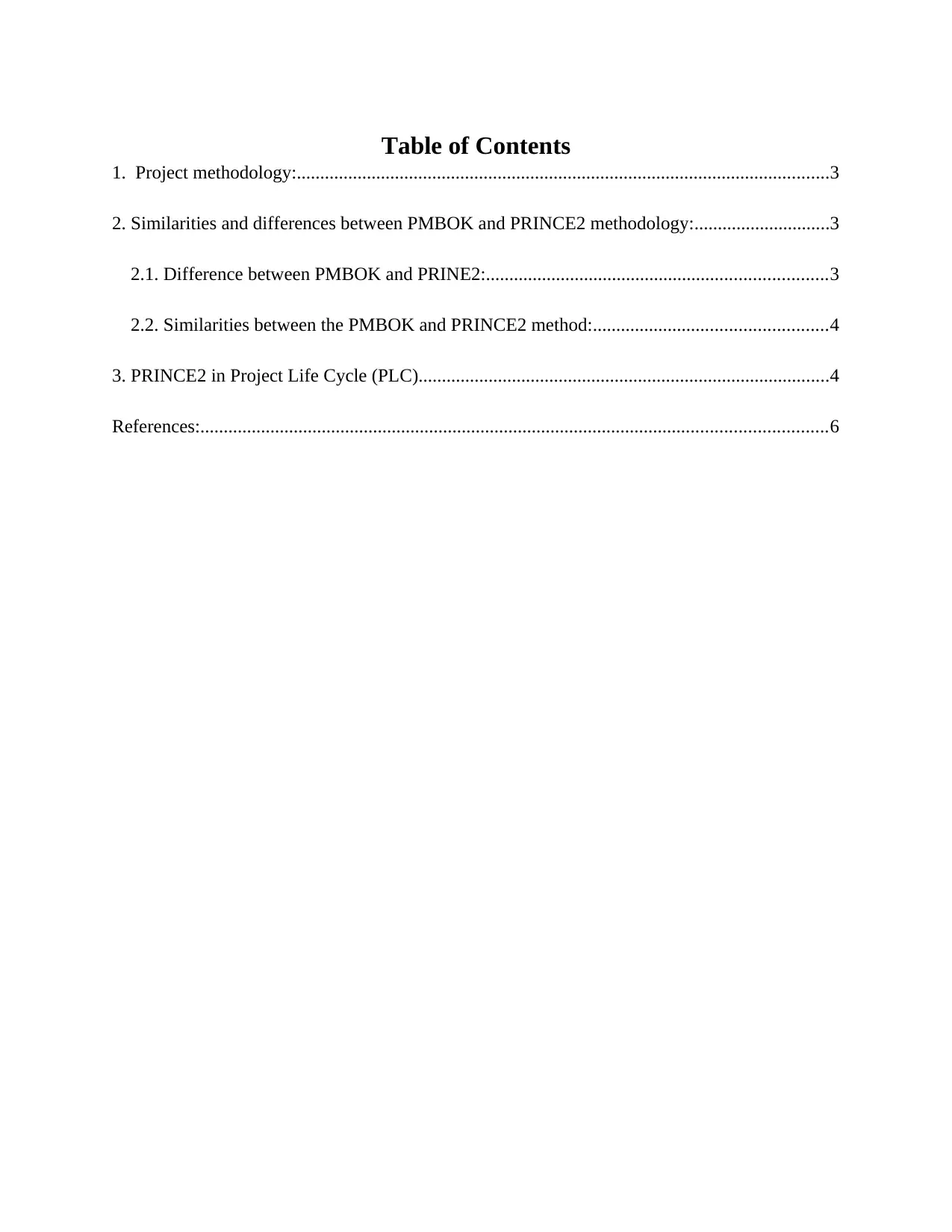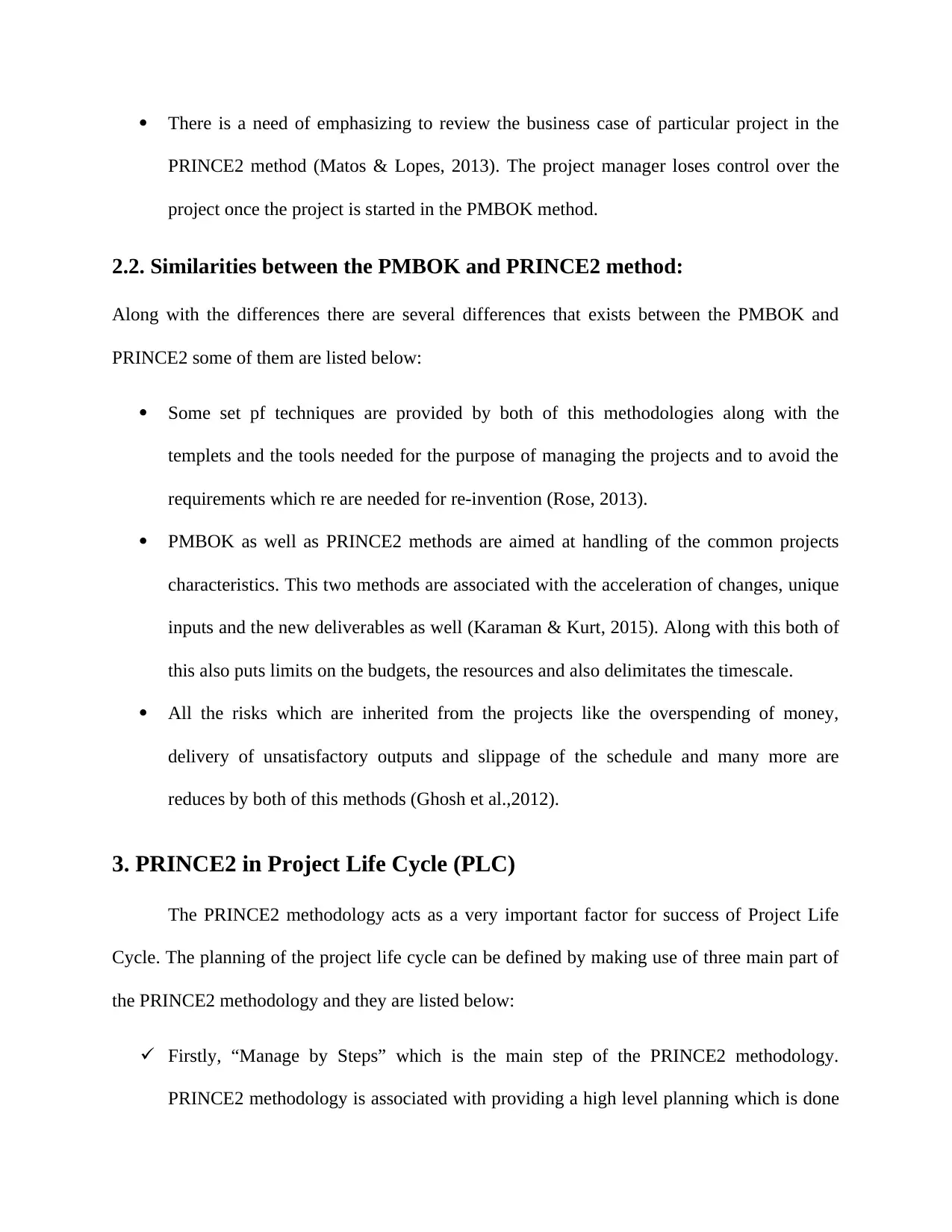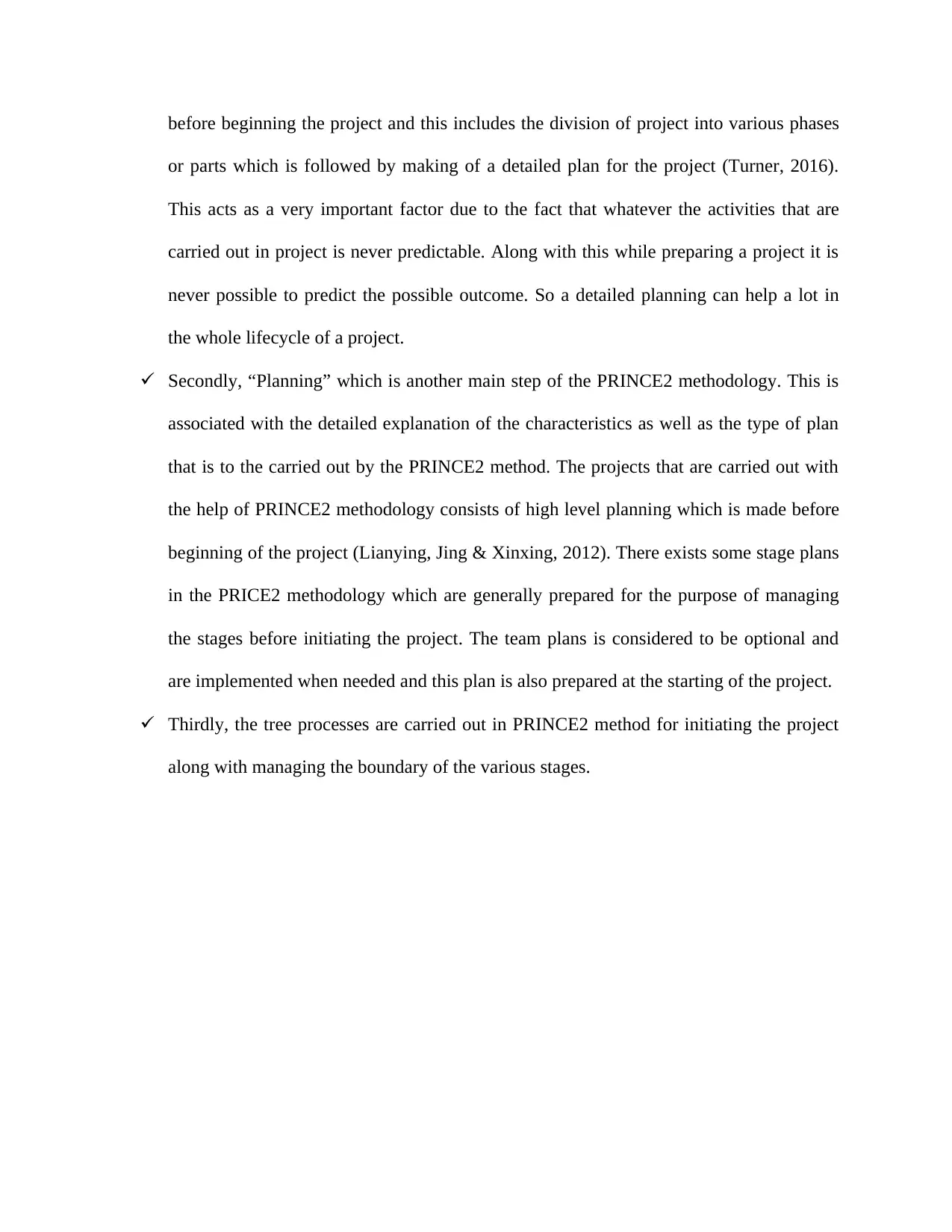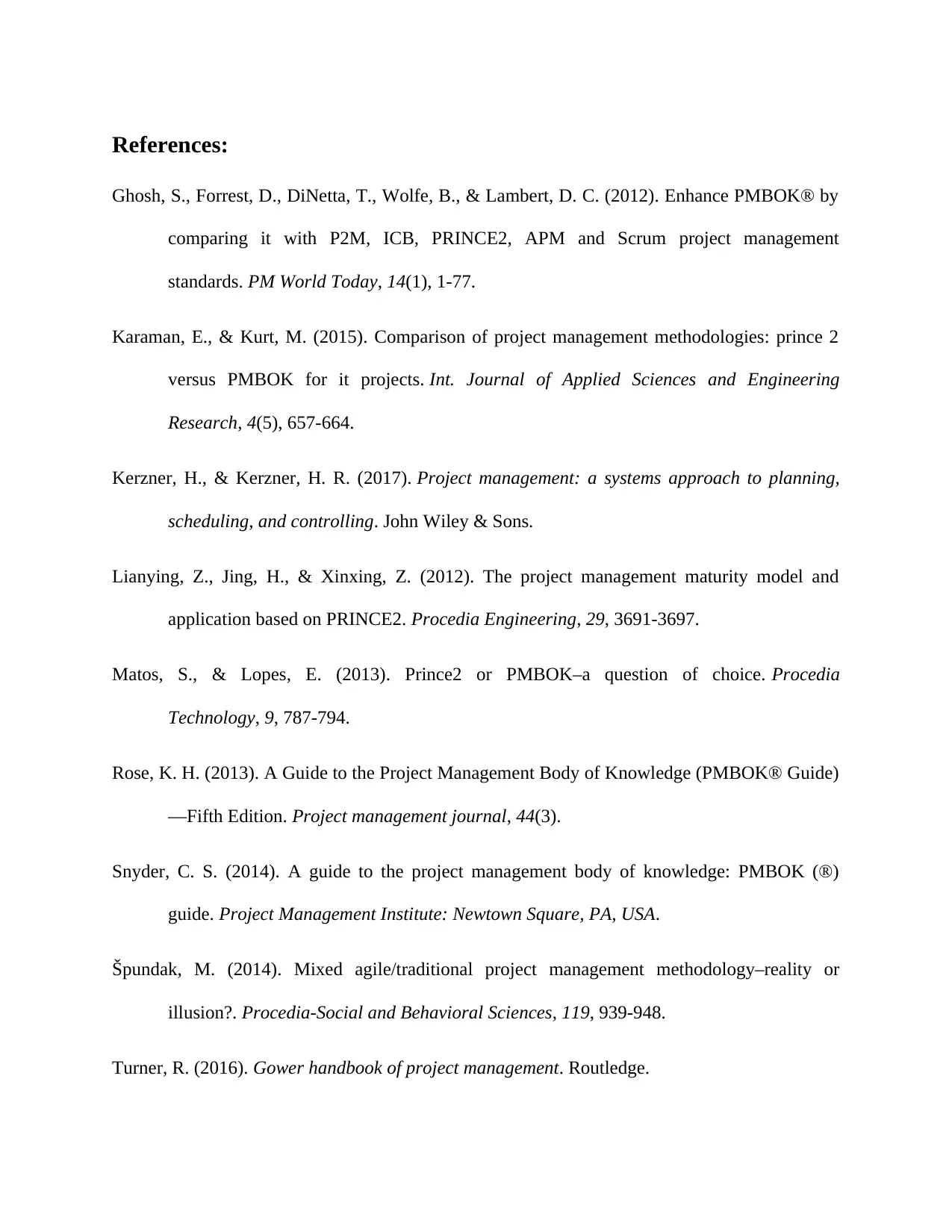Project Management Methodologies: PMBOK, PRINCE2 Comparison
VerifiedAdded on 2020/05/16
|7
|1205
|75
Report
AI Summary
This report provides a comparative analysis of two prominent project management methodologies: PMBOK (Project Management Body of Knowledge) and PRINCE2 (Projects IN Controlled Environments). The report begins by defining project methodology and its significance in guiding project processes. It then delves into a detailed comparison of PMBOK and PRINCE2, highlighting their key differences, such as PRINCE2's output-oriented approach versus PMBOK's emphasis on tools and guidelines. The report also identifies the similarities between the two methodologies, including their shared goals of effective project management and risk mitigation. Furthermore, the report explores the application of PRINCE2 within the Project Life Cycle (PLC), emphasizing its role in planning and managing project stages. The report references several scholarly sources to support its analysis.

Running head: PROJECT MANAGEMENT
Project Management
[Name of the Student]
[Name of the University]
[Author note]
Project Management
[Name of the Student]
[Name of the University]
[Author note]
Paraphrase This Document
Need a fresh take? Get an instant paraphrase of this document with our AI Paraphraser

Table of Contents
1. Project methodology:..................................................................................................................3
2. Similarities and differences between PMBOK and PRINCE2 methodology:.............................3
2.1. Difference between PMBOK and PRINE2:.........................................................................3
2.2. Similarities between the PMBOK and PRINCE2 method:..................................................4
3. PRINCE2 in Project Life Cycle (PLC)........................................................................................4
References:......................................................................................................................................6
1. Project methodology:..................................................................................................................3
2. Similarities and differences between PMBOK and PRINCE2 methodology:.............................3
2.1. Difference between PMBOK and PRINE2:.........................................................................3
2.2. Similarities between the PMBOK and PRINCE2 method:..................................................4
3. PRINCE2 in Project Life Cycle (PLC)........................................................................................4
References:......................................................................................................................................6

1. Project methodology:
Project methodology in a project management refers to the guiding process, which is used
by the persons involved in the project. Project methodology can also be defined as the five
different phases of project management and they are “define”, “plan”, “launch”, “manage” and
“closure” (Kerzner & Kerzner, 2017). Project methodology is used for the purpose of improving
the quality of the project by means of better management process. Project methodology consists
of guidelines, templets and definitions regarding various types of activities that are essential for
making successful completion of projects (Špundak, 2014). The project methodologies are
associated with providing a certain set of standards which in turn provides some tools and
processes for the project manager so as to make his/her job easy. A common ground is provided
by the project methodology for all type of projects.
2. Similarities and differences between PMBOK and PRINCE2
methodology:
2.1. Difference between PMBOK and PRINE2:
The common differences between PMBOK and PRINCE2 are listed below:
PRINCE2 is a method which is perspective in the outputs of the project management and
this might include the configuration records, logs, reports and the documents of baseline
(Snyder, 2014). Whereas in PMBOK method it is associated with the providing of proper
guidelines on the tools which might include the three point estimates, techniques of
gathering the information, matrices of the stakeholders and earned value analysis.
Project methodology in a project management refers to the guiding process, which is used
by the persons involved in the project. Project methodology can also be defined as the five
different phases of project management and they are “define”, “plan”, “launch”, “manage” and
“closure” (Kerzner & Kerzner, 2017). Project methodology is used for the purpose of improving
the quality of the project by means of better management process. Project methodology consists
of guidelines, templets and definitions regarding various types of activities that are essential for
making successful completion of projects (Špundak, 2014). The project methodologies are
associated with providing a certain set of standards which in turn provides some tools and
processes for the project manager so as to make his/her job easy. A common ground is provided
by the project methodology for all type of projects.
2. Similarities and differences between PMBOK and PRINCE2
methodology:
2.1. Difference between PMBOK and PRINE2:
The common differences between PMBOK and PRINCE2 are listed below:
PRINCE2 is a method which is perspective in the outputs of the project management and
this might include the configuration records, logs, reports and the documents of baseline
(Snyder, 2014). Whereas in PMBOK method it is associated with the providing of proper
guidelines on the tools which might include the three point estimates, techniques of
gathering the information, matrices of the stakeholders and earned value analysis.
⊘ This is a preview!⊘
Do you want full access?
Subscribe today to unlock all pages.

Trusted by 1+ million students worldwide

There is a need of emphasizing to review the business case of particular project in the
PRINCE2 method (Matos & Lopes, 2013). The project manager loses control over the
project once the project is started in the PMBOK method.
2.2. Similarities between the PMBOK and PRINCE2 method:
Along with the differences there are several differences that exists between the PMBOK and
PRINCE2 some of them are listed below:
Some set pf techniques are provided by both of this methodologies along with the
templets and the tools needed for the purpose of managing the projects and to avoid the
requirements which re are needed for re-invention (Rose, 2013).
PMBOK as well as PRINCE2 methods are aimed at handling of the common projects
characteristics. This two methods are associated with the acceleration of changes, unique
inputs and the new deliverables as well (Karaman & Kurt, 2015). Along with this both of
this also puts limits on the budgets, the resources and also delimitates the timescale.
All the risks which are inherited from the projects like the overspending of money,
delivery of unsatisfactory outputs and slippage of the schedule and many more are
reduces by both of this methods (Ghosh et al.,2012).
3. PRINCE2 in Project Life Cycle (PLC)
The PRINCE2 methodology acts as a very important factor for success of Project Life
Cycle. The planning of the project life cycle can be defined by making use of three main part of
the PRINCE2 methodology and they are listed below:
Firstly, “Manage by Steps” which is the main step of the PRINCE2 methodology.
PRINCE2 methodology is associated with providing a high level planning which is done
PRINCE2 method (Matos & Lopes, 2013). The project manager loses control over the
project once the project is started in the PMBOK method.
2.2. Similarities between the PMBOK and PRINCE2 method:
Along with the differences there are several differences that exists between the PMBOK and
PRINCE2 some of them are listed below:
Some set pf techniques are provided by both of this methodologies along with the
templets and the tools needed for the purpose of managing the projects and to avoid the
requirements which re are needed for re-invention (Rose, 2013).
PMBOK as well as PRINCE2 methods are aimed at handling of the common projects
characteristics. This two methods are associated with the acceleration of changes, unique
inputs and the new deliverables as well (Karaman & Kurt, 2015). Along with this both of
this also puts limits on the budgets, the resources and also delimitates the timescale.
All the risks which are inherited from the projects like the overspending of money,
delivery of unsatisfactory outputs and slippage of the schedule and many more are
reduces by both of this methods (Ghosh et al.,2012).
3. PRINCE2 in Project Life Cycle (PLC)
The PRINCE2 methodology acts as a very important factor for success of Project Life
Cycle. The planning of the project life cycle can be defined by making use of three main part of
the PRINCE2 methodology and they are listed below:
Firstly, “Manage by Steps” which is the main step of the PRINCE2 methodology.
PRINCE2 methodology is associated with providing a high level planning which is done
Paraphrase This Document
Need a fresh take? Get an instant paraphrase of this document with our AI Paraphraser

before beginning the project and this includes the division of project into various phases
or parts which is followed by making of a detailed plan for the project (Turner, 2016).
This acts as a very important factor due to the fact that whatever the activities that are
carried out in project is never predictable. Along with this while preparing a project it is
never possible to predict the possible outcome. So a detailed planning can help a lot in
the whole lifecycle of a project.
Secondly, “Planning” which is another main step of the PRINCE2 methodology. This is
associated with the detailed explanation of the characteristics as well as the type of plan
that is to the carried out by the PRINCE2 method. The projects that are carried out with
the help of PRINCE2 methodology consists of high level planning which is made before
beginning of the project (Lianying, Jing & Xinxing, 2012). There exists some stage plans
in the PRICE2 methodology which are generally prepared for the purpose of managing
the stages before initiating the project. The team plans is considered to be optional and
are implemented when needed and this plan is also prepared at the starting of the project.
Thirdly, the tree processes are carried out in PRINCE2 method for initiating the project
along with managing the boundary of the various stages.
or parts which is followed by making of a detailed plan for the project (Turner, 2016).
This acts as a very important factor due to the fact that whatever the activities that are
carried out in project is never predictable. Along with this while preparing a project it is
never possible to predict the possible outcome. So a detailed planning can help a lot in
the whole lifecycle of a project.
Secondly, “Planning” which is another main step of the PRINCE2 methodology. This is
associated with the detailed explanation of the characteristics as well as the type of plan
that is to the carried out by the PRINCE2 method. The projects that are carried out with
the help of PRINCE2 methodology consists of high level planning which is made before
beginning of the project (Lianying, Jing & Xinxing, 2012). There exists some stage plans
in the PRICE2 methodology which are generally prepared for the purpose of managing
the stages before initiating the project. The team plans is considered to be optional and
are implemented when needed and this plan is also prepared at the starting of the project.
Thirdly, the tree processes are carried out in PRINCE2 method for initiating the project
along with managing the boundary of the various stages.

References:
Ghosh, S., Forrest, D., DiNetta, T., Wolfe, B., & Lambert, D. C. (2012). Enhance PMBOK® by
comparing it with P2M, ICB, PRINCE2, APM and Scrum project management
standards. PM World Today, 14(1), 1-77.
Karaman, E., & Kurt, M. (2015). Comparison of project management methodologies: prince 2
versus PMBOK for it projects. Int. Journal of Applied Sciences and Engineering
Research, 4(5), 657-664.
Kerzner, H., & Kerzner, H. R. (2017). Project management: a systems approach to planning,
scheduling, and controlling. John Wiley & Sons.
Lianying, Z., Jing, H., & Xinxing, Z. (2012). The project management maturity model and
application based on PRINCE2. Procedia Engineering, 29, 3691-3697.
Matos, S., & Lopes, E. (2013). Prince2 or PMBOK–a question of choice. Procedia
Technology, 9, 787-794.
Rose, K. H. (2013). A Guide to the Project Management Body of Knowledge (PMBOK® Guide)
—Fifth Edition. Project management journal, 44(3).
Snyder, C. S. (2014). A guide to the project management body of knowledge: PMBOK (®)
guide. Project Management Institute: Newtown Square, PA, USA.
Špundak, M. (2014). Mixed agile/traditional project management methodology–reality or
illusion?. Procedia-Social and Behavioral Sciences, 119, 939-948.
Turner, R. (2016). Gower handbook of project management. Routledge.
Ghosh, S., Forrest, D., DiNetta, T., Wolfe, B., & Lambert, D. C. (2012). Enhance PMBOK® by
comparing it with P2M, ICB, PRINCE2, APM and Scrum project management
standards. PM World Today, 14(1), 1-77.
Karaman, E., & Kurt, M. (2015). Comparison of project management methodologies: prince 2
versus PMBOK for it projects. Int. Journal of Applied Sciences and Engineering
Research, 4(5), 657-664.
Kerzner, H., & Kerzner, H. R. (2017). Project management: a systems approach to planning,
scheduling, and controlling. John Wiley & Sons.
Lianying, Z., Jing, H., & Xinxing, Z. (2012). The project management maturity model and
application based on PRINCE2. Procedia Engineering, 29, 3691-3697.
Matos, S., & Lopes, E. (2013). Prince2 or PMBOK–a question of choice. Procedia
Technology, 9, 787-794.
Rose, K. H. (2013). A Guide to the Project Management Body of Knowledge (PMBOK® Guide)
—Fifth Edition. Project management journal, 44(3).
Snyder, C. S. (2014). A guide to the project management body of knowledge: PMBOK (®)
guide. Project Management Institute: Newtown Square, PA, USA.
Špundak, M. (2014). Mixed agile/traditional project management methodology–reality or
illusion?. Procedia-Social and Behavioral Sciences, 119, 939-948.
Turner, R. (2016). Gower handbook of project management. Routledge.
⊘ This is a preview!⊘
Do you want full access?
Subscribe today to unlock all pages.

Trusted by 1+ million students worldwide

1 out of 7
Related Documents
Your All-in-One AI-Powered Toolkit for Academic Success.
+13062052269
info@desklib.com
Available 24*7 on WhatsApp / Email
![[object Object]](/_next/static/media/star-bottom.7253800d.svg)
Unlock your academic potential
Copyright © 2020–2025 A2Z Services. All Rights Reserved. Developed and managed by ZUCOL.



